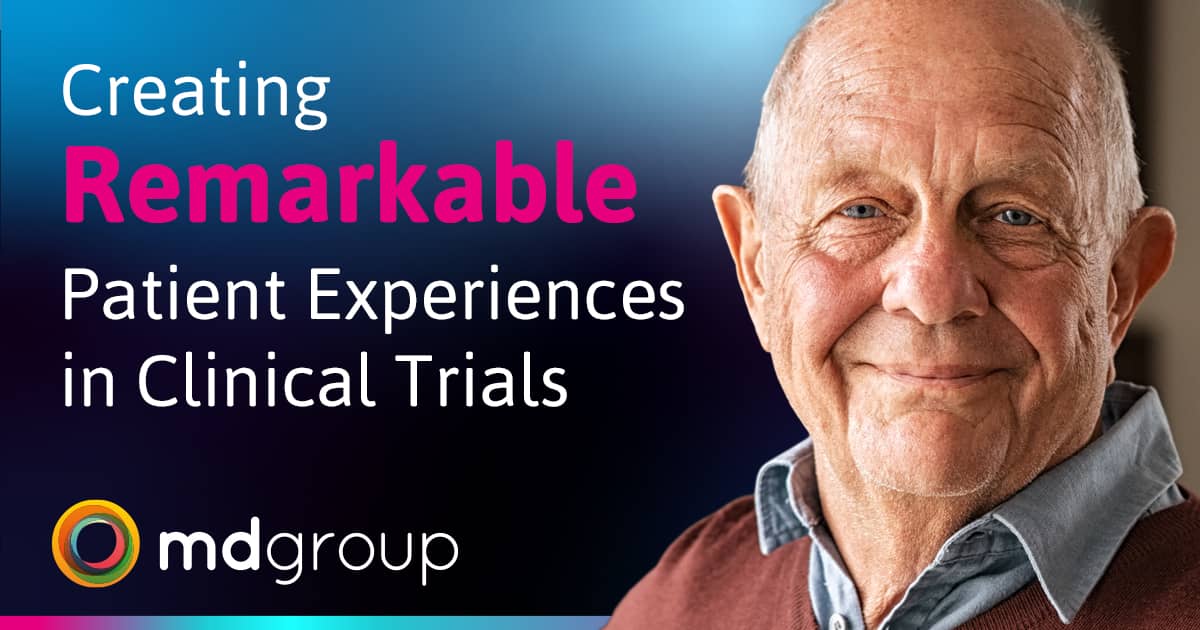
We should never underestimate the impact of clinical trial participation on patients and their families. Neither can we ignore that without their great courage and personal sacrifices, the development of life-changing drugs and therapies wouldn’t be possible.
Patient-centricity has become an industry buzzword in recent years, with an increased global discussion around how we can improve the patient experience. Yet many clinical trials still don’t provide patients with the support, communication and care they need to stay engaged.
In a recent report by Tufts Center for the Study of Drug Development (CSDD), 77% of clinical trials now meet or exceed their enrolment targets compared to just 47% in 2012. While patients are more willing to sign up for clinical trials, recruitment is only part of the picture.
Further reports show patient retention has not been rising alongside these figures, and it is estimated patient dropout remains as high as 40% in some trials.
In-line with an increased public awareness of clinical trials brought about by the pandemic, hybrid and decentralised (DCT) models became the norm wherever international or interstate travel was prohibited.
While decentralisation of clinical trials makes patient participation easier by increasing flexibility and eliminating the burden of travel, we still have a long way to go to ensure patients’ experiences in clinical trials are remarkable enough for them to remain engaged and complete the study.
So how do we put patients at the heart of a clinical study, and deliver remarkable experiences at every touch point? Let’s explore, with the help of patients.
What is a remarkable patient experience?
A remarkable patient experience is one that listens to the individual patient voice when designing protocols and processes. It takes their physical and emotional needs and day-to-day experiences into account when designing every element of a clinical study.
True patient-centricity must be proactive rather than reactive. While it’s important to stay agile and respond to any unplanned issues quickly, involving patients in trial design from the very beginning helps us to avoid many of the challenges, obstacles and frustrations that may arise.
To be successful we must also engage with and listen to patient communities. Encouraging them to share their experiences and continually evolve protocols, communication methods, processes, and technologies to meet the real-life needs of those participating in clinical trials.
Read More: Delivering Remarkable Patient Experiences in Clinical Trials
Building authentic, caring relationships with patients
As decentralised and hybrid clinical trials gain traction, going the extra mile to build relationships with patients is more important than ever.
With technology replacing in-person communication across so many study touchpoints, we must ensure that we don’t lose the human touch.
Eric Mayer, CEO of EDP Biotech is optimistic about the role of technology in improving the patient experience. He told us: “A lot of communication with the FDA and other regulators is being done virtually and the same is starting to happen with the consenting process. You can get information to the patient, explain the trial and follow up and obtain consent in a much more efficient manner.
“That helps the patient understand what you’re doing and how the follow up is going to take place. So you get efficiency built in, and you get improved participation because you’re getting options to the patient, empowering them in getting the data you need from a study standpoint, and they’re getting the patient care they need and deserve.”
Genuine relationships mean patients feel supported at every stage of the clinical journey. Recently, mdgroup Account Manager Odu Bamgbose was diagnosed with Non-Hodgkins Lymphoma. He went from helping patients as part of his job, to being the patient.
Odu shared his experience with us, and explained why it has made him even more passionate about building relationships with patients and understanding their concerns and experiences:
“When I went for my first biopsy, no one explained to me why they were doing it, or that they were checking to see if I had cancer. After my diagnosis, there was no one to discuss it with and explain the process to us as a family. The healthcare practitioners do point you in the direction of people who can help, but it’s you doing the work to get the support you need, rather than them coming to you.
“Maybe it’s because it was during COVID, and I had to go to appointments on my own, but that proactive support was missing. Patients need information and to understand what’s happening, and that just wasn’t there for us … One size doesn’t fit every patient. It’s crucial to consider, if you were in that position, how would you like to be treated?”
Read More: The Human Touch is Crucial, Odu’s story
Communicating with empathy and understanding
Exceptional communication, empathy and understanding are essential in building authentic relationships with patients. Genuinely connecting with people and putting them first is an art form, and it’s why we’re investing in formal training in the language of empathy for all our mdfamily members.
A patient isn’t just a number on a spreadsheet, they’re a human being with complex needs and expectations. When we seek to listen, understand and learn from patients, we can identify potential issues in protocols before they arise, respond quickly to any issues that occur, and deploy resources to help them on their journey. That’s what builds trust and respect, which is key to any lasting relationship.
The increasing complexity of protocols alongside the advancement of medical technology are other reasons why communication is more important in clinical trials than it has ever been. We must and will resist the temptation to rely on technology alone.
Successful clinical trials are always a hybrid of technology and the human touch.
In our 2020 mdWebinar on improving the patient experience, Nuala Ryan, a Clinical Research Consultant who also has experience as a cancer patient, told us: “Protocols have gotten more complex in the last few years. If you look at what’s involved in the procedures and objectives, it does demand more of patients than before. That’s why more support is needed.”
Director of Tufts Center for the Study of Drug Development (CSDD), Ken Getz, echoes Ryan’s opinion, telling CenterWatch Weekly: “It’s harder to find and retain study volunteers given the eligibility criteria and the demands that are placed on participants in trials … the average number of endpoints per trial in the 2017 to 2020 period [was] 27% higher than in the period from 2009 to 2012 … with the greatest rate of growth occurring since the 2013 to 2016 period.”
With this increased complexity in what’s required of patients, finding ways to keep communication channels open, and provide patients with the information they need in the way they need it, is an essential part of the patient experience.
Read more: Delivering Remarkable Patient Experiences in Clinical Trials
Hearing patients’ stories
When we’re designing trial protocols and looking to expand the services we offer to patients, listening to patient stories helps us appreciate their worlds and identify potential issues with study design – as well as areas where more specialised and tailored support may be needed.
On Rare Disease Day 2021, we invited Rachael Mole, co-founder of Sick In The City, to share her experience as a patient with a rare disease with the mdgroup team. She highlighted the difficulties she faces day to day as a result of her conditions, which would impact her participation in a clinical study: “I was diagnosed with Ehlers Danlos Syndrome Hypermobility Type 3, about four or five years ago. I’ve also been diagnosed with Postural Tachycardia, and Mast Cell Disorder … I have to pace myself every day. If I’m doing one activity, I have to really understand how that’s going to impact my energy levels to take into consideration the next activity I’m doing that day or even the next day and the day after that.
“I can wake up one day and the same activity the day before will take even more energy, or maybe I’ll wake up and it will take less energy. It’s really a bit of an energy roller coaster … I have to stop myself from getting out of bed sometimes purely because the level of pain plus fatigue and brain fog becomes a bit too much. Even though I probably could power through, it’s learning that actually, I shouldn’t.”
In our mdWebinar on improving the patient experience, Carole Scrafton, Co-Founder and Chair of FibroFlutters, echoed the importance of understanding how patients experience their conditions and the impact clinical trial participation will have on their health.
Speaking from her experience of running a Patient Advocacy organisation for patients with chronic illnesses and rare diseases, she says: “If you’re a patient with ME, for instance, a long journey is going to wipe you out. When you get there, you need time to rest and recover before you go for an appointment, which means you’re going to require a hotel stay of at least one night before you go to the trial site.”
Scrafton also highlighted the importance of making accommodations for patients’ mental health as well as physical health: “Some people just can’t leave the house. They haven’t got the mobility to do it. Social anxiety is another big issue, because when you’ve been stuck in the house for a long time, in some cases you could be talking years, it’s very difficult to actually go outside and get on a bus, or get on a train. Even if you have somebody with you, it can still be very, very difficult.”
As clinical trial models continue to evolve, we must seek to be as inclusive of all patients when it comes to protocols. Racheal Mole also underlined how vital this is, telling us: “We need to be careful that as we progress, as we have our voices heard and as we champion each other, that we don’t forget there are people with disabilities who can’t speak for themselves, who don’t know how to, or who have exceptionally rare diseases. We must ensure they are not left behind.”
Read more: An insight into the patient experience with Rachael Mole
The role of patient advocacy
One of the most important ways we can understand patients’ experiences, concerns and needs is to build relationships with patient advocacy groups and individual patient advocates.
Patient advocates are regularly speaking to people who are involved in clinical trials or receiving treatment for particular diseases. They are well practised in offering advice and insight, and speaking up on behalf of wider patient communities. They have their finger on the pulse when it comes to common and topical issues surrounding patient advice, care, treatment, and communication.
One such advocate, Chris Ojeda, is a full-time caregiver for his son, who has a rare terminal disease. He actively participates in online groups for patients and caregivers, sharing his extensive knowledge and personal experiences of being involved in clinical trials to support other parents who are on the same challenging journey.
Chris spoke to us about the importance of communicating effectively with patients about the wider aspects of their clinical journeys and providing support wherever possible.
He says: “I’ve been through a lot of dead ends, and I’ve worked out how to deal with a lot of different things from insurances to government support. That’s a lot of work. You can do a lot of research, speak to a lot of people, and just go in circles. With the knowledge and experience I have, I know I can help a lot of parents.”
Our interview also highlighted the importance of engaging with patient advocacy groups to educate people even before they begin their clinical trial journey, answering questions and dispelling common myths that create barriers to participation.
Chris told us: “When people think about clinical trials, there is a lot of fear. I’ve even had friends say some pretty harsh things, like: “This is a horrible thing you’re doing, making your son a guinea pig.” But when you engage with the pharmaceutical companies, when they put on events and have speakers, they’re able to answer your questions in person.
“They can step aside from the research and jargon, and speak in terms that parents can understand. Engaging in this sort of thing helps people connect, and get past some of their barriers and biases.”
Read Chris’s Story: Why Patient Advocacy Matters
Getting patients involved at every stage of the clinical journey
Having a patient-first mindset from the very early stages of clinical trial design and development is crucial for creating remarkable patient experiences. This mindset begins at the top with executive leadership, and travels all the way down to the front lines – ensuring patients are put first long before they’re enrolled.
Our ethos has always been to put patients first across all our innovations at mdgroup. It’s a crucial part of our DNA. Far too often we’ve seen organisations waste time and money by discussing solutions in a boardroom without considering the patient experience.
We’ve learned that listening to patients as early as possible in the design process, and inviting them to be part of the solution, is invaluable.
Andrew Schorr, Co-founder and President at Patient Power LLC, describes this as “treating patients like investors”.
He told us in an mdWebinar: “What I mean by that is respect, communication, keeping people informed. When we talk about patients dropping out, we also need to ask, have they been kept informed about how the trial is going overall, their role in it, what the goals are of the trial, how their participation is making a difference, and what’s expected of them along the way?
“And then, If you get to the goal and a drug is approved, thank the people who were in the trial. Let them know what happened. Patients are not guinea pigs, but going back over many years, that’s the way people have felt – like they’re a number rather than a person and an investor.”
Watch in full: How Can We Improve the Patient Experience in Clinical Trials?
The role of technology in humanising the patient experience
In the wake of the COVID-19 pandemic, technology has boomed across all sectors – and the clinical research industry is no exception. Innovation has been fast-tracked, enabling decentralised clinical trials and hybrid models in a way we’ve hoped to see for years. And it looks like these changes are here to stay.
A recent study by Oracle Health Sciences revealed 76% of respondents had accelerated their decentralised trials since 2020. And it’s no wonder – the COVID-19 vaccine trials have been some of the largest in history. Without technology, they wouldn’t have been possible amidst the disruption to travel and contact caused by the pandemic.
One of our core focuses as a business is how technological advancement can enhance the patient experience in numerous ways, including:
- Taking the site to the patient with mobile health and telehealth visits
- Giving patients choice about their participation – such as how they plan their appointments and communicate with study organisers – ensuring minimal disruption to their lives
- Empowering patients by giving them more control over their participation, such as how they gather and share data
- Keeping patients engaged through video calls, automated reminders, and digital check-ins
- Integrating trial protocols into their day to day lives through compatibility with existing devices such as smartphones, smartwatches and other wearable devices.
Our Chief Technology Officer Neil Barfield is hugely passionate about driving innovation to create remarkable patient experiences, and has been putting that passion into action by spearheading the development of our in-house technology platforms, primarius and heron.
Neil says: “I describe primarius as an ecosystem. It has multiple functions, and underpins all the services mdgroup offers. It provides tools, solutions and data for our teams to deliver remarkable experiences and services to patients, and also provides direct technology to patients.
“For example, providing mobile and web applications where a patient can log in and get the information they need to support them in the study, get to know the nurses who will be caring for them, understand the site and what to expect from their visits, and manage their travel and expenses.”
Read More: How Technology Boosts Recruitment and Retention Rates in Clinical Trials
In summary, ensuring patients’ experience of clinical trial participation involves:
- Personalised support and exceptional communication
- Listening to patient voices and learning from their experiences
- Recognition of the value patients provide to clinical research
- Involving patients in design of trial protocols, starting in the boardroom
- Using technology to give patients autonomy and empowerment
That’s our commitment to creating remarkable.







